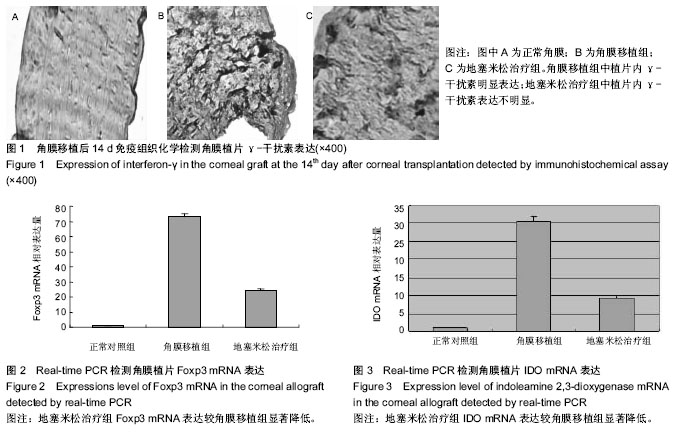| [1] Price MO,Thompson RW,Price FW.Risk factors for various causes of failure in initial corneal grafts. Arch Ophthalmol. 2003;121(8):1087-1092.[2] Amouzegar A, Chauhan SK, Dana R.Alloimmunity and Tolerance in Corneal Transplantation.J Immunol. 2016; 196(10):3983-3991.[3] Stephens LA,Barclay AN,Mason D.Phenotypic characterization of regulatory CD4+CD25+T cells in rats. Int Immunol.2004;16(2):365-375.[4] Ohkura N,Kitagawa Y,Sakaguchi S.Development and maintenance of regulatory T cells.Immunity. 2013;38(3): 414-423.[5] Al-Wedaie F, Farid E, Tabbara K, et al. T-regulatory cells in chronic rejection versus stable grafts. Exp Clin Transplant. 2015;13 Suppl 1:170-176.[6] Hattori T,Takahashi H,Dana R.Novel Insights Into the Immunoregulatory Function and Localization of Dendritic Cells.Cornea.2016;35 Suppl 1:S49-S54.[7] Chauhan SK,Saban DR,Lee HK,et al.Levels of Foxp3 in regulatory T cells reflect their functional status in transplantation. J Immunol.2009;182(1):148-153.[8] 章传凯,沈振亚,滕晓梅,等.骨髓间充质干细胞联合白细胞介素-6单克隆抗体诱导大鼠心脏移植免疫耐受的研究[J].中华实验外科杂志, 2017,34(3):427-432.[9] Munn DH, Sharma MD, Lee JR, et al. Potential regulatory function of human dendritic cells expressing indoleamine 2,3-dioxygenase. Science.2002;297(5588):1867-1870.[10] He Y,Zhou S,Liu H,et al.Indoleamine 2, 3-Dioxgenase Transfected Mesenchymal Stem Cells Induce Kidney Allograft Tolerance by Increasing the Production and Function of Regulatory T Cells.Transplantation.2015;99(9):1829-1838.[11] Sonoda Y,Streilein JW.Orthotopic corneal transplantation in mice--evidence that the immunogenetic rules of rejection do not apply.Transplantation.1992;54(4):694-704.[12] Skurkovich S,Kasparov A,Narbut N,et al.Treatment of corneal transplant rejection in humans with anti-interferon-gamma antibodies. Am J Ophthalmol.2002;133(6):829-830.[13] 周琨,高晓唯,蔡岩,等.CCR7基因修饰未成熟树突状细胞诱导大鼠高危角膜移植免疫耐受[J].中华实验眼科杂志, 2015,33(10): 902-908. [14] 苏亚茹,白浪,汤明芳,等.敲除TLR2基因对同种异体小鼠角膜移植排斥反应的影响[J].眼科新进展.2016,36(11):1006-1010.[15] 李斐,张琰,茹玉莎,等.结膜下注射间充质干细胞对大鼠角膜移植物生存的影响[J].中华实验眼科杂志. 2015,33(5):440-445.[16] Bauer TM,Jiga LP,Chuang JJ,et al.Studying the immunosuppressive role of indoleamine 2,3-dioxygenase: tryptophan metabolites suppress rat allogeneic T-cell responses in vitro and in vivo. Transpl Int.2005;18(1):95-100.[17] Hosseini-Tabatabaei A, Jalili RB, Khosravi-Maharlooei M,et al.Immunoprotection and Functional Improvement of Allogeneic Islets in Diabetic Mice, Using a Stable Indoleamine 2,3-Dioxygenase Producing Scaffold.Transplantation. 2015; 99(7):1341-1348. [18] Chung DJ,Rossi M,Romano E,et al.Indoleamine 2,3-dioxygenase-expressing mature human monocyte- derived dendritic cells expand potent autologous regulatory T cells.Blood.2009; 114(3):555-563.[19] He Y,Zhou S,Liu H, et al.Indoleamine 2, 3-Dioxgenase Transfected Mesenchymal Stem Cells Induce Kidney Allograft Tolerance by Increasing the Production and Function of Regulatory T Cells.Transplantation.2015; 99(9):1829-1838. [20] Kunishige T,Taniguchi H,Terada M,et al.Protective Role of ICOS and ICOS Ligand in Corneal Transplantation and in Maintenance of Immune Privilege.Invest Ophthalmol Vis Sci. 2016;57(15):6815-6823.[21] 王启明,赵心悦,王智,等.未成熟树突状细胞诱导辅助型T细胞偏移抑制大鼠高危角膜移植排斥反应的研究[J].眼科新进展. 2016, 36(10):919-922.[22] Cook CH, Bickerstaff AA, Wang JJ, et al. Spontaneous renal allograft acceptance associated with "regulatory" dendritic cells and IDO.J Immunol.2008;180(5):3103-3112.[23] Tahvildari M,Omoto M,Chen Y,et al.In Vivo Expansion of Regulatory T Cells by Low-Dose Interleukin-2 Treatment Increases Allograft Survival in Corneal Transplantation. Transplantation.2016; 100(3):525-532. [24] Beutelspacher SC, Pillai R, Watson MP, et al. Function of indoleamine 2,3-dioxygenase in corneal allograft rejection and prolongation of allograft survival by over-expression.Eur J Immunol.2006; 36(3):690-700.[25] Serbecic N, Lahdou I, Scheuerle A, et al. Function of the tryptophan metabolite, L-kynurenine, in human corneal endothelial cells. Mol Vis.2009;15:1312-1324.[26] Hautz T, Brandacher G, Zelger B,et al.Indoleamine 2,3-dioxygenase and foxp3 expression in skin rejection of human hand allografts. Transplant Proc.2009;41(2):509-512.[27] Lahdou I,Engler C,Mehrle S,et al.Role of human corneal endothelial cells in T-cell-mediated alloimmune attack in vitro. Invest Ophthalmol Vis Sci.2014;55(3):1213-1221. |
.jpg) 文题释义:
角膜移植免疫:角膜移植免疫反应是导致角膜移植术后失败的主要原因。常规角膜移植成功率较高,但高危角膜移植(新生血管、再次移植等)术后角膜植片存活率明显降低。角膜移植免疫反应具体发病机制尚未明确,是一复杂、多因素参与的反应过程,主要是以T淋巴细胞介导为主的迟发型超敏反应。
Foxp3:Foxp3是重要的负调节蛋白,是CD4+CD25+Tr发育及免疫功能的维持与转录因子,在调控CD4+CD25+Tr细胞的发育和功能发挥上起重要的作用。
IDO(吲哚胺2,3-二氧化酶):是位于细胞浆中含亚铁血红素的酶,是色氨酸代谢的限速酶,它可通过降解局部组织中的色氨酸影响淋巴细胞的功能,在肿瘤逃逸、母胎耐受、慢性感染、自身免疫性疾病和移植免疫中发挥重要的免疫调节作用。
文题释义:
角膜移植免疫:角膜移植免疫反应是导致角膜移植术后失败的主要原因。常规角膜移植成功率较高,但高危角膜移植(新生血管、再次移植等)术后角膜植片存活率明显降低。角膜移植免疫反应具体发病机制尚未明确,是一复杂、多因素参与的反应过程,主要是以T淋巴细胞介导为主的迟发型超敏反应。
Foxp3:Foxp3是重要的负调节蛋白,是CD4+CD25+Tr发育及免疫功能的维持与转录因子,在调控CD4+CD25+Tr细胞的发育和功能发挥上起重要的作用。
IDO(吲哚胺2,3-二氧化酶):是位于细胞浆中含亚铁血红素的酶,是色氨酸代谢的限速酶,它可通过降解局部组织中的色氨酸影响淋巴细胞的功能,在肿瘤逃逸、母胎耐受、慢性感染、自身免疫性疾病和移植免疫中发挥重要的免疫调节作用。.jpg) 文题释义:
角膜移植免疫:角膜移植免疫反应是导致角膜移植术后失败的主要原因。常规角膜移植成功率较高,但高危角膜移植(新生血管、再次移植等)术后角膜植片存活率明显降低。角膜移植免疫反应具体发病机制尚未明确,是一复杂、多因素参与的反应过程,主要是以T淋巴细胞介导为主的迟发型超敏反应。
Foxp3:Foxp3是重要的负调节蛋白,是CD4+CD25+Tr发育及免疫功能的维持与转录因子,在调控CD4+CD25+Tr细胞的发育和功能发挥上起重要的作用。
IDO(吲哚胺2,3-二氧化酶):是位于细胞浆中含亚铁血红素的酶,是色氨酸代谢的限速酶,它可通过降解局部组织中的色氨酸影响淋巴细胞的功能,在肿瘤逃逸、母胎耐受、慢性感染、自身免疫性疾病和移植免疫中发挥重要的免疫调节作用。
文题释义:
角膜移植免疫:角膜移植免疫反应是导致角膜移植术后失败的主要原因。常规角膜移植成功率较高,但高危角膜移植(新生血管、再次移植等)术后角膜植片存活率明显降低。角膜移植免疫反应具体发病机制尚未明确,是一复杂、多因素参与的反应过程,主要是以T淋巴细胞介导为主的迟发型超敏反应。
Foxp3:Foxp3是重要的负调节蛋白,是CD4+CD25+Tr发育及免疫功能的维持与转录因子,在调控CD4+CD25+Tr细胞的发育和功能发挥上起重要的作用。
IDO(吲哚胺2,3-二氧化酶):是位于细胞浆中含亚铁血红素的酶,是色氨酸代谢的限速酶,它可通过降解局部组织中的色氨酸影响淋巴细胞的功能,在肿瘤逃逸、母胎耐受、慢性感染、自身免疫性疾病和移植免疫中发挥重要的免疫调节作用。
.jpg) 文题释义:
角膜移植免疫:角膜移植免疫反应是导致角膜移植术后失败的主要原因。常规角膜移植成功率较高,但高危角膜移植(新生血管、再次移植等)术后角膜植片存活率明显降低。角膜移植免疫反应具体发病机制尚未明确,是一复杂、多因素参与的反应过程,主要是以T淋巴细胞介导为主的迟发型超敏反应。
Foxp3:Foxp3是重要的负调节蛋白,是CD4+CD25+Tr发育及免疫功能的维持与转录因子,在调控CD4+CD25+Tr细胞的发育和功能发挥上起重要的作用。
IDO(吲哚胺2,3-二氧化酶):是位于细胞浆中含亚铁血红素的酶,是色氨酸代谢的限速酶,它可通过降解局部组织中的色氨酸影响淋巴细胞的功能,在肿瘤逃逸、母胎耐受、慢性感染、自身免疫性疾病和移植免疫中发挥重要的免疫调节作用。
文题释义:
角膜移植免疫:角膜移植免疫反应是导致角膜移植术后失败的主要原因。常规角膜移植成功率较高,但高危角膜移植(新生血管、再次移植等)术后角膜植片存活率明显降低。角膜移植免疫反应具体发病机制尚未明确,是一复杂、多因素参与的反应过程,主要是以T淋巴细胞介导为主的迟发型超敏反应。
Foxp3:Foxp3是重要的负调节蛋白,是CD4+CD25+Tr发育及免疫功能的维持与转录因子,在调控CD4+CD25+Tr细胞的发育和功能发挥上起重要的作用。
IDO(吲哚胺2,3-二氧化酶):是位于细胞浆中含亚铁血红素的酶,是色氨酸代谢的限速酶,它可通过降解局部组织中的色氨酸影响淋巴细胞的功能,在肿瘤逃逸、母胎耐受、慢性感染、自身免疫性疾病和移植免疫中发挥重要的免疫调节作用。